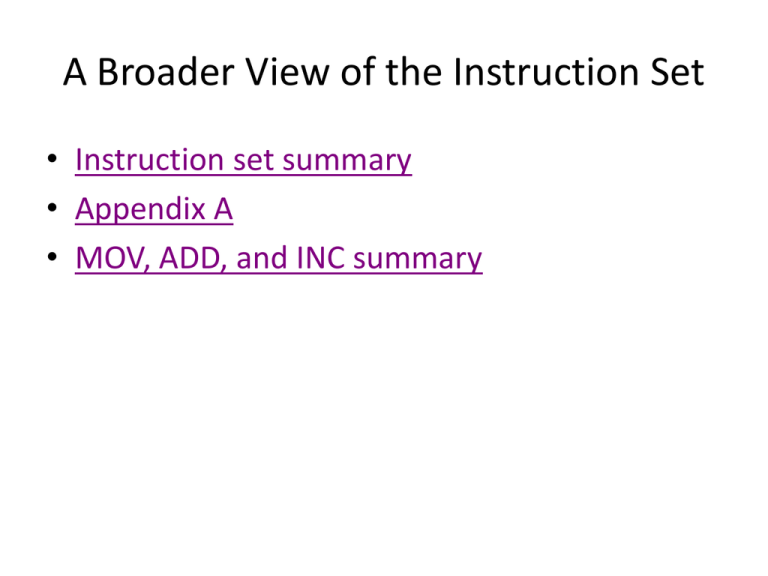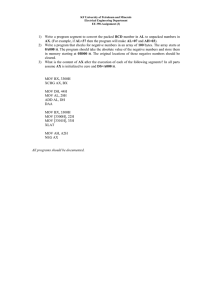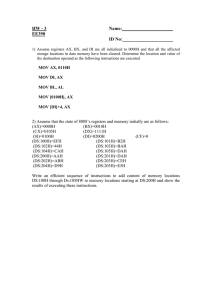
A Broader View of the Instruction Set
• Instruction set summary
• Appendix A
• MOV, ADD, and INC summary
Clock Cycles vs. Instruction Cycles
The clock signal used by a PIC24 μC to control instruction execution can be
generated by an off-chip oscillator or crystal/capacitor network, or by using the
internal RC oscillator within the PIC24 μC.
For the PIC24H family, the maximum clock frequency is 80 MHz.
An instruction cycle is two clock cycles.
Important!!!!!!!
A PIC24 instruction takes 1 or 2 instruction cycles, depending on the instruction
(see Table 19-2, PIC24HJ32GP202 data sheet). If an instruction causes the
program counter to change, that instruction takes 2 instruction cycles.
An add instruction takes 1 instruction cycle. How much time is this if the clock
frequency is 80 MHz ( 1 MHz = 1.0e6 = 1,000,000 Hz)?
1/frequency = period, 1/80 MHz = 12.5 ns (1 ns = 1.0e-9 s)
1 Add instruction @ 80 MHz takes 2 clocks * 12.5 ns = 25 ns (or 0.025 us).
By comparison, an Intel Pentium add instruction @ 3 GHz takes 0.33 ns (330 ps). An
Intel Pentium could emulate a PIC24HJ32GP202 faster than a PIC24HJ32GP202 can
execute! But you can’t put a Pentium in a toaster,
or buy one from Digi-key for $5.00.58
V 0.1
How long does mptst_byte.s take to execute?
Beginning at the __reset label, and ignoring the goto at the end,
takes 12 instruction cycles, which is 24 clock cycles.
Instruction
Cycles
mov #__SP_init, W15
mov #__SPLIM_init,W0
mov W0,SPLIM
mov.b #avalue, W0
mov.b WREG,i
inc.b
i
mov.b
i,WREG
mov.b
WREG,j
dec.b
j
mov.b
i,WREG
add.b
j,WREG
mov.b
WREG,k
V 0.1
Total
1
1
1
1
1
1
1
1
1
1
1
1
12
59
What if we used 16-bit variables instead
of 8-bit variables?
C Program equivalent
A uint16 variable is
16 bits (1 byte)
#define avalue 2047
uint16 i,j,k;
i = avalue;
// i = 2047
i = i + 1;
// i++, i = 2048
j = i;
// j is 2048
j = j - 1;
// j--, j is 2047
k = j + i;
// k = 2095
V 0.1
60
.include "p24Hxxxx.inc"
.global __reset
.bss
;reserve space for variables
i:
.space 2
j:
.space 2
k:
.space 2
Reserve 2 bytes for each
variable. Variables are now
stored at 0x0800, 0x0802,
0x0804
.text
;Start of Code section
__reset: ; first instruction located at __reset label
mov #__SP_init, w15
;initialize stack pointer
mov #__SPLIM_init,W0
mov W0,SPLIM
;initialize stack limit reg
avalue = 2048
; i = 2048;
mov #avalue, W0
mov WREG,i
; i = i +
inc
; j = i
mov
mov
; j = j –
dec
; k = j +
mov
add
mov
done:
goto
1;
i
Instructions now
perform WORD (16-bit)
operations (the .b
qualifier is removed).
; W0 = 2048
; i = 2048
; i = i + 1
i,WREG
WREG,j
1;
j
i
i,WREG
j,WREG
WREG,k
done
; W0 = i
; j = W0
; j= j – 1
; W0 = i
; W0 = W0+j
; k = W0
;loop forever
(WREG is W0)
V 0.1
61
Copyright Delmar Cengage Learning 2008. All Rights Reserved.
How long does mptst_word.s take to execute?
Ignoring the goto at the end, takes 12 instruction cycles, which
Instruction
is 24 clock cycles.
Cycles
mov #__SP_init, W15
mov #__SPLIM_init,W0
mov W0,SPLIM
mov #avalue, W0
mov WREG,i
inc
i
mov
i,WREG
mov
WREG,j
dec
j
mov
i,WREG
add
j,WREG
mov
WREG,k
Total
V 0.1
1
1
1
1
1
1
1
1
1
1
1
1
12
62
16-bit operations versus 8-bit
The 16-bit version of the mptst program requires the same number of
instruction bytes and the same number of instruction cycles as the 8-bit
version.
This is because the PIC24 family is a 16-bit microcontroller, its natural
operation size is 16 bits, so 16-bit operations are handled as efficiently as 8bits operations.
On an 8-bit processor, like the PIC18 family, the 16-bit version would take
roughly double the number of instructions and clock cycles as the 8-bit
version.
On the PIC24, a 32-bit version of the mptst program will take approximately
twice the number of instructions and clock cycles as the 16-bit version. We
will look at 32-bit operations later in the semester.
V 0.1
63
Review: Units
In this class, units are always used for physical qualities:
Time
Frequency
milliseconds (ms = 10-3 s)
kilohertz (kHz = 103 Hz)
microseconds (μs = 10-6 s)
megahertz (MHz = 106 Hz)
(ns = 10-9 s)
gigahertz (GHz = 109 Hz)
nanoseconds
When a time/frequency/voltage/current quantity is asked for, I
will always ask from some units. Values for these quantities in
datasheets ALWAYS are given in units.
For a frequency of 1.25 kHz, what is the period in μs?
period = 1/f = 1/(1.25 e3) = 8.0 e –4 seconds
Unit conversion= 8.0e-4 (s) * (1e6 μs)/1.0 (s) = 8.0e2 μs = 800 μs
V 0.1
64




